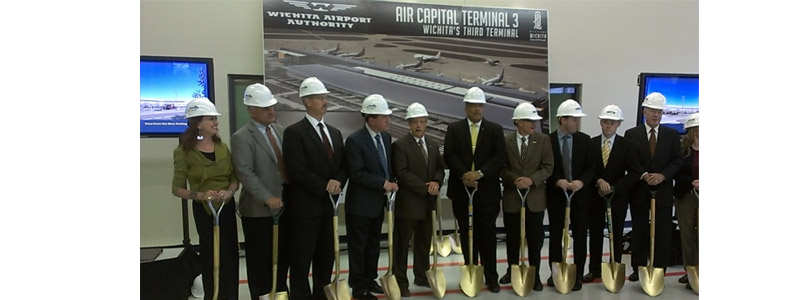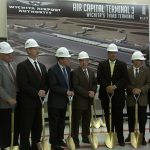Air Capital Breaks Ground On New Airport Terminal
09.20.12 · Sonia Greteman
Good things come to those who wait. Eight years after the Wichita City Council voted to build a new airport terminal, we’ve broken ground. Hallelujah!
Our Wichita-based agency – Greteman Group – has been involved practically from the start. Our role as public art consultant: to tell the story of Wichita’s incomparable aviation history. We’ve been there, sleeves rolled up, working with the architects designing the aviation-inspired terminal. It’s been a privilege. Years before crowdsourcing became the term du jour, we created an online forum and opened it up to some of the most knowledgeable, impassioned aviation enthusiasts you’ll find anywhere. We developed an advisory board comprised of area aircraft manufacturers, suppliers, historians and some of the history makers themselves. And, oh, the stories we’ve heard.
We were able to speak to such people as Moya Lear, whose headstrong genius of a husband, Bill, created the jet set. To Rosie the Riveters who helped round-the-clock wartime Wichita churn out more than four B-29s a day during the height of WWII. To Al Mooney’s son whose 23-year-old dad opened a Wichita aircraft plant in 1929 and built the Mooney M-5 a mere seven months later. To colleagues and family members of the legendary Walter and Olive Ann Beech, one of only two couples ever inducted into the Aviation Hall of Fame. (The other is Charles and Anne Lindbergh.)
Preserve and Proclaim
Kansas celebrated 100 years of flight in 2011, giving us a wealth of history to draw upon. In the early 20th century, Kansas visionaries, like their contemporaries the world around, dreamt of flight. Amateur engineers from one corner of the state to the other drew up daring plans. Some put hammer to nail and built their flying contraptions. Most failed. Yet nothing stopped the dreaming.
Before the Wright Brothers ever got off the ground, Carl Dryden Browne built a flying-machine factory in Freedom, Kansas. He earned the first U.S. rotary-wing aircraft patent, but lack of fundscaused his factory to fold after just two years.
On Sept. 2, 1911, Albin Longren became the first person to build and fly an airplane in Kansas. His pusher-type biplane lifted off from a hayfield southeast of Topeka with a four-gallon gas tank and “flight instruments” that consisted of a pocket watch and barometer. Despite the fact he had never flown, Longren made eight successful flights the first day. He went on to careers in barnstorming, aircraft design and manufacturing, earning the nickname “The Henry Ford of the Air.”
One of the most influential of these early birds was neither an aircraft designer nor a pilot; he was a wealthy oilman by the name of Jacob “Jake” Moellendick. He sunk every penny of his vast wealth into the advancement of aviation in Wichita in the 1910s and ’20s and died in 1940 without enough cash to pay for his funeral. But Moellendick left a rich legacy. He brought E.M. “Matty” Laird, Lloyd Stearman and Walter Beech together and bankrolled their ideas – giving birth to Wichita aviation with the E.M. Laird Airplane Co.
Clyde Cessna, Walter Beech and Lloyd Stearman all worked together at Wichita’s Travel Air. Each man brought a unique talent pivotal to the company’s success – Beech, a gifted businessman and promoter; Cessna, a skilled mechanic who could fix almost anything; and Stearman, an exceptional designer with an intimate understanding of mass production. It was a once-in-a-lifetime collaboration that made Travel Air the major aircraft manufacturer of the 1920s.
Kansas Aviation Museum historian Walt House said, “The early aviation pioneers saw Wichita as one big landing field.” By 1928, Wichita was turning out a quarter of all U.S. aircraft. The city boasted 16 airplane manufacturers, six engine factories, 11 airports, a dozen flying schools and numerous suppliers.
ACT 3
Wichita’s new terminal will actually be the city’s third. Hence the name, Air Capital Terminal 3, or ACT 3. The first, in southeast Wichita, transferred to the United States Air Force back to 1951 and became part of McConnell Air Force Base. The second opened in southwest Wichita to general aviation in 1953 and to commercial carriers in 1954. It was built in a couple of years for the then-sizable sum of $10 million. Of course, there’ve been changes over the years. Added concourses in 1976. Additional gates and updates in 1985. A $6 million renovation in 1989. The terminal did its job.
Then came 9/11.
The terrorist attacks on Sept. 11, 2001 prompted federal officials to establish new security specifications. Our once welcoming, efficient terminal became a crowded, uncomfortable bottleneck. Passengers had to wind their way through a narrow corridor never designed to serve as a security queue with TSA officials, X-ray machines, metal detectors, plastic bins, conveyor belts, screening areas and passengers increasingly inclined to carry on as much luggage as possible.
Security wasn’t the only issue for the state’s largest and busiest airport. As one of the nation’s older terminals, it also had to meet new accessibility and building code guidelines. It needed an update of its electrical, heating and cooling systems and more. All led to our City Council’s vote in 2004 to build a new terminal. We’ve had a few setbacks along the way – mainly the deep recession in 2008 that put a kibosh on more than just a new terminal. But let’s not go there.
Here Comes the Sun
In spite of a steady rain that drove the ceremonial groundbreaking on September 13 indoors, spirits were sunny.
Mayor Carl Brewer beamed. “The new terminal will be the airline gateway to the State of Kansas,” he said. “It will serve as a front window into our city and our history. Visitors will know that Wichita gave birth to aircraft manufacturing and that more aircraft have been built here than anywhere in the world.”
The $160 million project includes the $101.5 million terminal, a $40 million parking garage and other enhancements. No local tax dollars are being used. The project is funded by user fees (leasing, parking, rental car, concession) and federal grants. Equally good for Wichita, construction will create 1,250 jobs – a plus in this still-rebounding economy.
Inspired by Flight
The new terminal’s taking shape next door to the current one, which will eventually be torn down. I love the design created by Kansas City, Mo.-based HNTB in association with Wichita’s GLMV Architecture. Its flight theme feels so right for our community.
“The building is designed to reflect the importance of the history and future of aviation in Wichita,” said Philip Hannon, HNTB senior project manager. “The shape of the roof is designed to remind visitors of flight and an aircraft’s wing. Other elements of the design also reinforce this theme, including large naturally lit passenger spaces with generous glazing and skylights that will maintain a link with the outside and its changing sky.”
Key Construction of Wichita and Walbridge of Detroit won the construction bid to realize the architects’ vision. The new two-story, 273,000-square-foot terminal will be larger than the current terminal’s single-story 195,00 square feet.
Victor White, Director of Airports for the Wichita Airport Authority said, “We are all proud, thrilled and happy to see the results of nearly 11 years of planning come to fruition. This new terminal will provide our customers with a facility that is modern, efficient, and beautiful, and which delivers a significantly higher level of customer service. The entire passenger experience will be enhanced and memorable for visitors to the Air Capital.”
Project Highlights
- Significantly enlarged ticketing and baggage claim on the roadway entry level.
- Upper-level concourse with departure lounges and aviation-heritage exhibit space, enhanced concessions (both pre- and post-security screenings).
- Expanded and enhanced passenger security screening, designed to not just meet current TSA security standards, but hopefully future ones.
- Twelve boarding gates, each with a passenger boarding bridge. That’s huge for passengers accustomed to lugging carry-on luggage down steps, going outside and boarding aircraft on the tarmac/apron.
- Four-level covered garage with rental-car ready/return accessed by covered crosswalks. (Construction begins in 2013.)
Ascending Artistry
In our role as public art consultant for the terminal, in 2009 we spearheaded the artist search. We reviewed more than 100 international, national, regional and local artist portfolios. The result: the selection of Ed Carpenter for commissioned artwork. His proposed 330-foot-long light sculpture evokes the feeling of ascending and descending in its use of laminated dichroic glass and cables. The tension structure creates an arc with 60 transverse cables anchored along the wall. It appears to float above the ticketing counters, baggage claim and central mezzanine lobby. Escalator riders get good and close. Its proximity to the skylights creates continually changing light patterns on the walls and floor below. Prepare to be wowed.
True to our Heritage
Kudos to the Wichita Airport Authority – whose advisory board is the Wichita City Council – which manages the airport. It has shown true leadership in greenlighting this much-needed project.
I think about the early barnstormers and their death-defying spins and dives. Of those turn-of-the-century entrepreneurs willing to invest their fortunes on a concept. And I believe they would be proud. As Mayor Carl Brewer said, “We live on the plains, but we keep our eyes to the skies.”
*This article originally appeared in the September 19 issue of BlueSky Business Aviation News.

